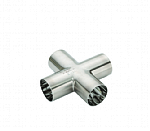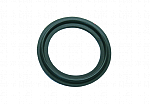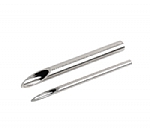

Glossary
Alloy
A material composed of two or more metals which are mixed and united - usually when they are in a molten state. Alloys are created to improve properties such as the appearance, strength and durability of metals. Common alloys include cast iron, stainless steel, brass, bronze, sterling silver and alpha cellulose, that part of a material made of cellulose that is insoluble in a 17.5% solution of sodium hydroxide at20°C under specified conditions. While alpha cellulose consists principally of cellulose, it does include other components that are insoluble under the test conditions.
American Society for the Testing & Materials
ASTM
Creates consensus standards for material quality and material quality testing methods
American Society of Mechanical Engineers
ASME
Creates consensus standards for Mechanical Engineering.
Aseptic
Free of pathogenic (disease causing) micro-organisms.
ASTM-A 269
ASTM-A269
Specification titled "Seamless and Welded Austenitic Stainless Steel Tubing for General Service". This specification covers a variety of grades of austenitic stainless steel tubing.
ASTM-A 270
ASTM-A 270
Specification titled "Welded Austenitic Stainless Steel Tubing" for use in the pharmaceutical industries and need to withstand secondary cold forming operations. This specification covers a variety of grades of austenitic stainless steel tubing.
B31.3 ASME Process Piping
B31.3
American National Standard that covers piping typically found in pharmaceutical, semiconductor, and cryogenic plants, and related processing plants and terminals. It must be noted that B31.3 does not address hygienic tubing and/or piping; it applies mostly to inspection, examination, and testing of systems.
Bio Processing Equipment
BPE
ASME Standard is intended forthe design, materials, construction, inspection and testing of vessels, piping and related process components used in the biopharmaceutical industry and other aseptic applications.
Bio Processing Equipment Committee
BPEC
A sub-committee ofthe ASME BPE Main committee working to develop the ASME BPE standard while meeting three times per year.
Chemical reaction
The process by which chemicals combine with each other to form products, which differ from, or alter, the original substances.
Clean in Place
CIP
The technique of cleaning process line components without the need for disassembly.
Conductivity
Measurement of a substance's ability to conduct an electric current.
current Good Manufacturing Practice
cGMP
Written and enforced by the FDA. Consists of some specific, but mostly "umbrella" regulations covering personnel, records, and equipment, leaving much to the interpretation of the Inspector and the court system. cGMP's are evolutionary, reflecting the least common denominator of practices in the industry at present (hence the term "current").
Dead Leg
A section of pipe in a closed recirculation loop that does not have a continuous flow through it.
Deutsches Institut fur Normung (German Institute for Standardization)
DIN
Creates engineering standards for Germany Contributing body to CEN and ISO. Other countries and companies give adopted DIN standards.
Electron Spectroscopy for Chemical Analysis
ESCA
A procedure that uses electron beams to characterize the extreme outer surface of a metal. Typically used to determine levels of chromium oxide on the surface of austenitic stainless steel.
Electro-Polish
EP or E/P
Polishing process for metal components where the part is placed in an acid bath (typically sulfuric or phosphoric) containing a cathode. As current is passed through the cathode, metal ions are removed from the surface of the metal.
Epidemiology
Study of the distribution and determinants of diseases in populations.
European Hygienic Equipment Design Group
EHEDG
Comprised of representatives from research institutes, equipment manufacturers, the food and bio-pharm industry and legislative bodies. The group's objective is to provide standardization organizations (CEN and ISO) with specialist views on hygienic and aseptic design by publishing requirements and test methods.
Fermentation
The biochemical synthesis of organic compounds by microorganisms or cultivated cells.
Food and Drug Administration (USA)
FDA
Enforcement agency of the U.S. government for food, drug and cosmetics manufacturing. Authorofthe U.S. cGMP's. Responsible for new product approvals, plant inspections and product recalls.
Gas Tungsten Arc Welding
GTAW
(a.k.a. TIG) A welding process where the welding arc is maintained between a non-consumable tungsten electrode and the base metal to be welded. The arc is shielded with an inert gas, typically argon.
Good Manufacturing Practices
GMP
Refers specifically to FDA cGMP's (see cGMP) or to the standards of manufacturing in a particular country and industry (e.g.:EU GMP). Generally refers to standards that are written and enforced.
Heat Tracing
Permanent identification used to trace a part back to the mill heat (batch) from which the part was manufactured. Each heat number traces back to an MTR (see MTR).
International Society for Pharmaceutical Engineering
ISPE
A global not-for-profit membership organization that provides education, training and technical publications to pharmaceutical manufacturing professionals.
International Standards Organization
ISO
Creates consensus standards for engineering and quality systems.
Joining Techniques
Connections between tube and tube or tube and fitting, and even tube/fitting to equipment during system fabrication and/or construction can be accomplished by diverse means.
Mill Test Report or Material Test Report
MTR
(a.k.a. "Mill Certs") A document certifying the composition of a metal from a particular heat batch.
Orbital Welding
An automated TIG (or GTAW) welding process that is designed to produce repeatable fusion welds for tubular components. A system consists of a programmable power supply and weld head. The power supply controls the weld parameters of current and electrode speed. The weld head holds the two parts, purges the weld and moves the electrode using an electric motor.
Ovality
A quantitative measurement of how 'round' a tube is by comparing width to height. Limits are specified on the appropriate ASTM specification of a product.
Parenteral Drug Association
PDA
Association for manufacturers of injectable drug products. Publishes technical reports and other publications of interest to the industry.
Passivation
The process of rinsing stainless steel with acid (typically nitric) to form a corrosion resistant chromium-oxide layer on the surface.
Pharma-coepidemiology
The study of the utilization and effects of drugs in large numbers of people. To accomplish this study, pharmacoepidemiology borrows from both pharmacology and epidemiology.
Point of Use
POU
A valved branch in a recirculating utility system (typically a water system).
Process Qualification/ Process Validation
PQ/PV
The demonstration and documentation that the various units and procedures of a process operate as they should. This logically establishes that the product is of the quality the system is purported to yield. Performed after the IQ/OQ has been executed and approved. Typically, the acceptance criteria is the same as the product acceptance criteria, and the product run is considered product-for-sale. Executed by the manufacturing personnel of the operating company according to the SOP.
Roughness Average (Ra)
Ra
An expression of measured surface roughness or texture, typically, of a polished or machined metal surface. The arithmetic average value of the departure (peaks and valleys) of a surface profile from the center-line throughout the sampling length, generally expressed in micro-inch(^in) or micro-meter(|jm) units and measured with profilometers and/or orescopes.
Seamless Pipe
Pipe produced from a solid billet that is heated and rotated under pressure. This rotating pressure creates a hole in the middle of the billet, which is then formed into a pipe by a mandrel.
Solvent Cleaning
The removal of contaminants such as oil, grease, dirt, salts, etc. by cleaning with a solvent, steam, vapor, alkali, or emulsion.
Standard Operating Procedure
SOP
(a.k.a. EOP, OP) A controlled document that outlines the procedure for operating equipment/ systems. An operator's adherence to a written SOP is an integral part of the validation process. It is the connecting link between the initial validation process and the daily manufacturing operation.
Steam in Place
SIP
Sanitization of process line components by the use of steam without the need for disassembly.
Sterile
Free of living organisms.
Sulfur
A non-metallic element that exists in several forms-the ordinary one being a yellow, rhombic, crystalline solid-and which burns with a blue flame and a suffocating smell. Some sulfur compounds, particularly sulphides and oxides, can cause severe chemical deterioration in objects.
Surface Finish
SF
Surface finishes are all interior surface finishes accessible and inaccessible, that directly or indirectly come in contact with the designated product in bioprocessing equipment and distribution system components. Surface roughness specification and measurement standard shall be determined by Ra values rather than by polishing methods.
Tubing Dimensions
O.D. - outside diameter
I.D. - inside diameter
Wall thickness or gauge.
All tube dimensions are specific; pipe dimensions are nominal. Specific - actual measurements in inches. Nominal - theoretical or stated value of a dimension.
Tungsten Inert Gas
TIG
(a.k.a. GTAW) A welding process where the welding arc is maintained between a non-consumable tungsten electrode and the base metal to be welded. The arc is shielded with an inert gas, typically argon.
Ultra Filter or Ultra-Filtration
UF
Filters formed from polymer membranes. UFs have the ability to retain larger molecules while permitting the passage of smaller ones. Often used for the separation of proteins
Ultraviolet Light or Ultraviolet Radiation
UV
Radiation in the ultraviolet portion of the spectrum (200 to 400 nm) is used to destroy micro-organisms. Also used to neutralize ozone.
US Pharmaceutical Class VI-XXII
USP
An official public standards-setting authority for healthcare products manufactured and sold in the United States. USP sets standards for the quality of these products which are also recognized and used outside the United States.
Water For Injection
WFI
Water for use as a solvent for the preparation of parenteral products conforming to USPXXIII (EP and JP) guidelines. Obtained most commonly by distillation. However, other processes are allowed depending on particular pharmacopoeia.
Welded Tubing
Tubular products, which are rolled, formed and then joined continuously along a longitudinal seam by a material fusion process. The process employed at Gibson Tube is, Gas Tungsten Arc Welding (GTAW). See Gas Tungsten Arc Welding'.





















